Our top ten things to know about the wildlife of Rathlin

Rathlin Island is a wonderful place for wildlife, and we’re lucky enough to have spent loads of time here watching, searching, finding, photographing and recording as much as we can. We have so much to share about what we’ve learned and the extraordinary things that occur here, it’s hard to know where to start! But anyway, we have had a go at highlighting the major things here.
So below we list our top ten things we think you should know about the wildlife of Rathlin. Click the links or images below to jump to each topic in the list.
- Rathlin has an immense and spectacular seabird colony (much more than just Puffins!)
- Rathlin is an incredible hotspot for marine biodiversity
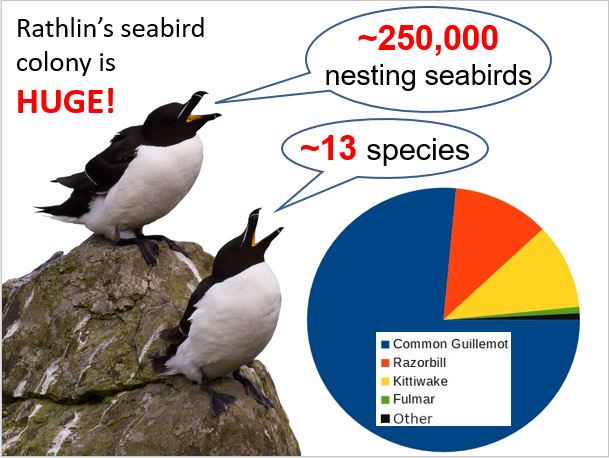

- Rathlin is brilliant for birdwatching – over 220 species of bird have been recorded here
- When is the best time to visit Rathlin? ANY TIME! There is much to enjoy and discover throughout the year


- Rathlin has a golden form of the Irish Hare that is unique to the island
- Rathlin is home to two species of seal

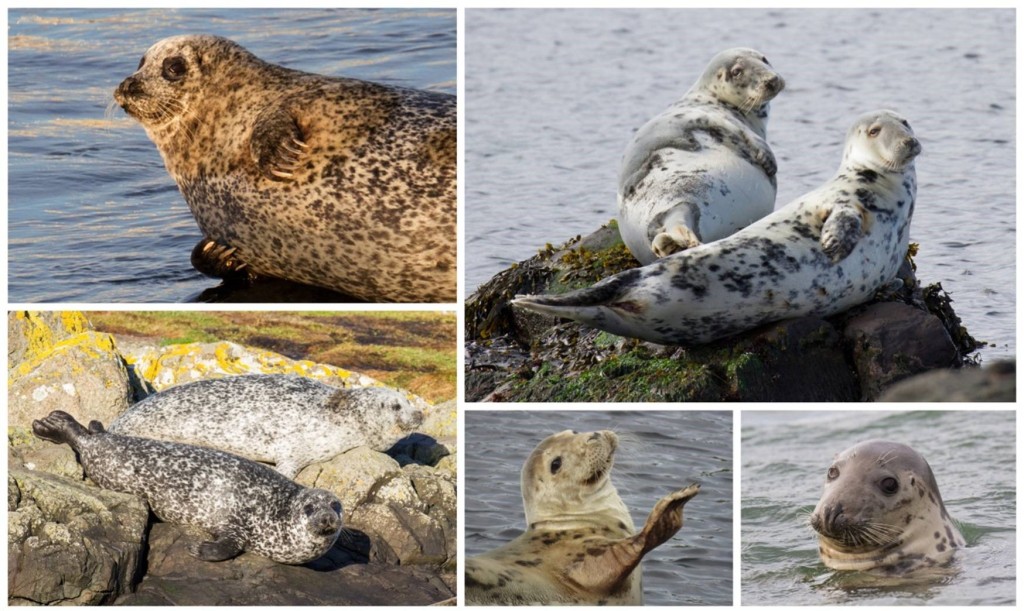
- Rathlin has wonderful wildflowers and a rich flora including numerous species that are rare in NI
- Rathlin has a high diversity of grassland fungi including waxcaps


- Nearly 500 species of moths (including 19 butterflies) have been recorded on Rathlin
- New things are being discovered all the time and there is lots still to learn!
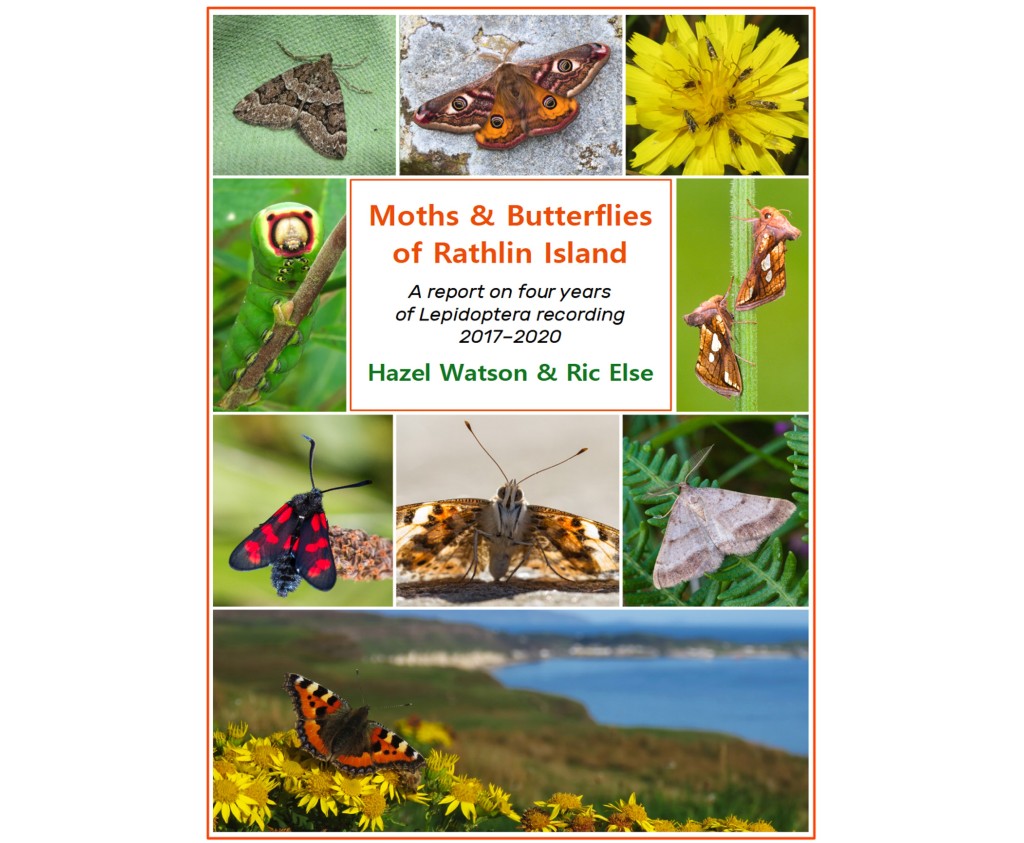
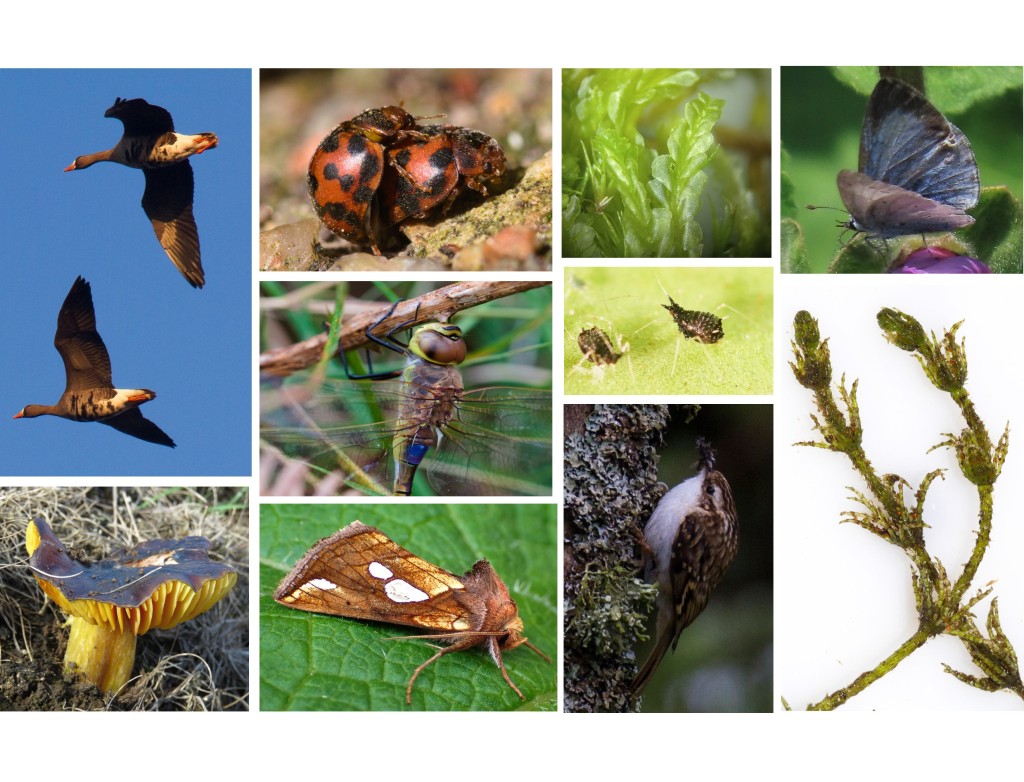
[A wee note on the order of our top ten. There’s no way to present a list like this without putting them in some sort of order, and we don’t intend the order we’ve used here to represent any particular hierarchy of importance or significance of one taxon above any other. But we have factored in how easy it is for an observer to witness these things for themselves, so seabirds are our number one as the cliff colonies are as obvious and accessible as they are impressive, while more specialist stuff is presented lower down, even though it may also be highly significant.]
1. Rathlin has an immense and spectacular seabird colony (much more than just Puffins!)

It’s usually Puffins that get the most attention, but what Rathlin should really be famous for is its incredible Common Guillemots! These underrated and overlooked auks occur here in such staggering numbers that it is the single largest colony in all of Ireland and GB.

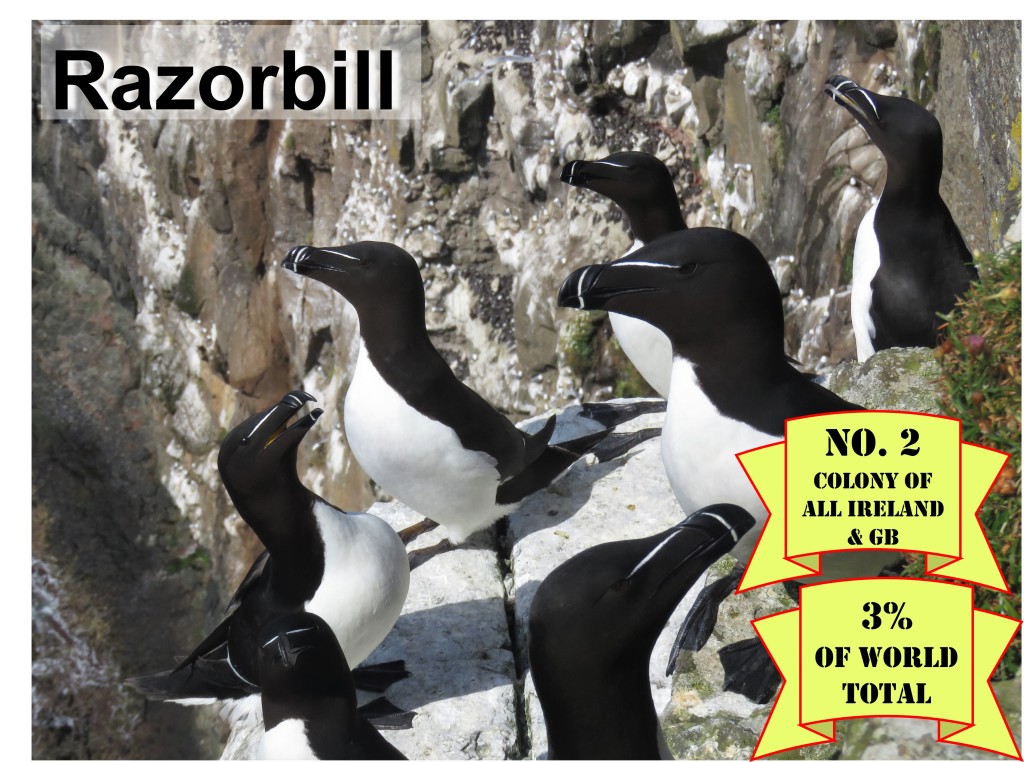
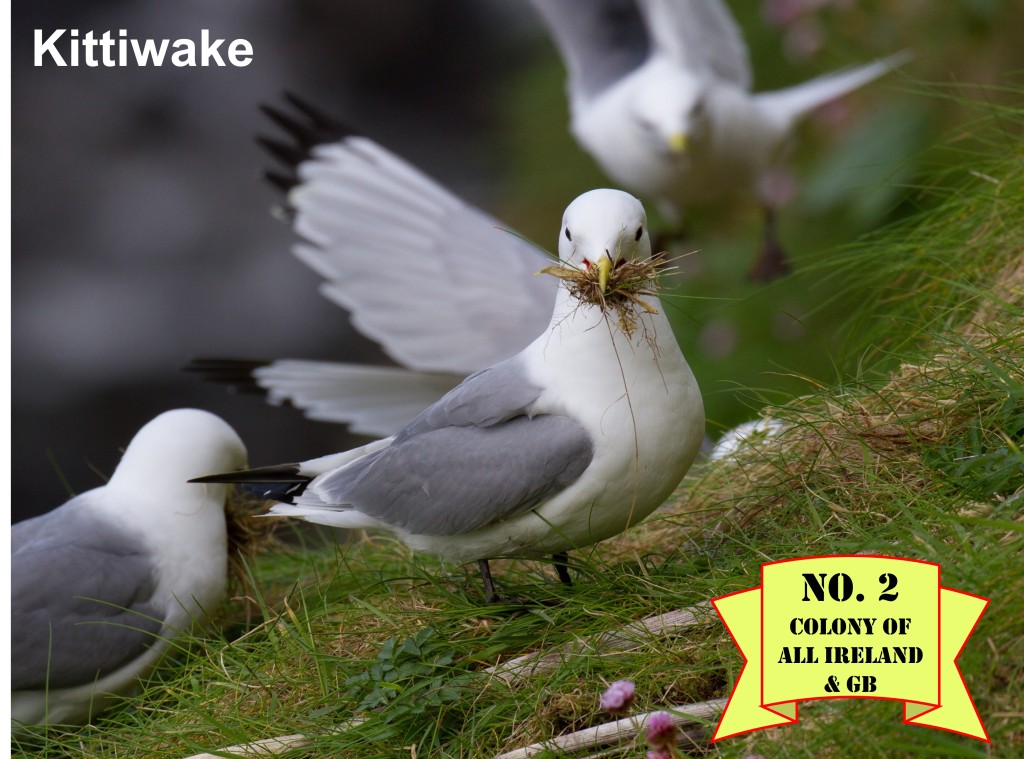

Rathlin can also boast the second largest colony for both Razorbills and Kittiwakes. As Razorbills have a more limited breeding distribution, the many thousands nesting on Rathlin probably represents a small but significant percentage of the estimated global population of Razorbills. Kittiwakes have had a string of successful breeding seasons on Rathlin in recent years, and their increasing population here has been bucking the trends seen at many other sites. Rathlin also hosts other seabird species that breed in smaller numbers but still represent Northern Ireland’s biggest colonies, including Puffins, Fulmars, Shags and Black Guillemots, and a pair of Great Skuas nesting on Rathlin is still the only pair in NI.

Another thing that sets Rathlin’s seabird colony apart is that compared with many seabird colonies, it is remarkably easy to get to and view! The island is only a short ferry ride from Ballycastle with multiple sailings operating daily right through the seabird nesting season (and beyond). From land the easiest place to view seabirds is from the lighthouse platform at the Rathlin West Light Seabird Centre, and a boat trip around the island is the best way to truly appreciate the epic size and scale of the seabird colony.
Most people only get to view a tiny fraction of the Rathlin seabird nesting season, but as we’ve spent many seasons observing this seabird soap opera right the way through, we put together a film that shows all of the drama month by month. We’ve also made a YouTube playlist of other Rathlin seabird clips too.
We’ve recorded lots of detail (e.g. dates, productivity, unusual observations) about the seabird colony in our annual Rathlin Bird Reports, particularly the 2021-2022 and 2020 editions. So that’s the best place to look if you want to know when the Puffins arrive and leave, when and how to see jumplings, or what else you can expect to see at any point in the Rathlin seabird nesting season.
2. Rathlin is an incredible hotspot for marine biodiversity
We’ll leave it to the marine experts to tell you about the exceptional underwater life of Rathlin… a great place to start is this talk by Christine Morrow:
Christine explains the factors that create such high biodiversity in the waters around the island, and illustrates some of the otherworldly creatures living down there. A particular highlight to watch out for is a colonial anemone that may be NI’s only population of Parazoanthus axinellae, or it may in fact be a distinct species that is not yet described, and may be unique to Rathlin.
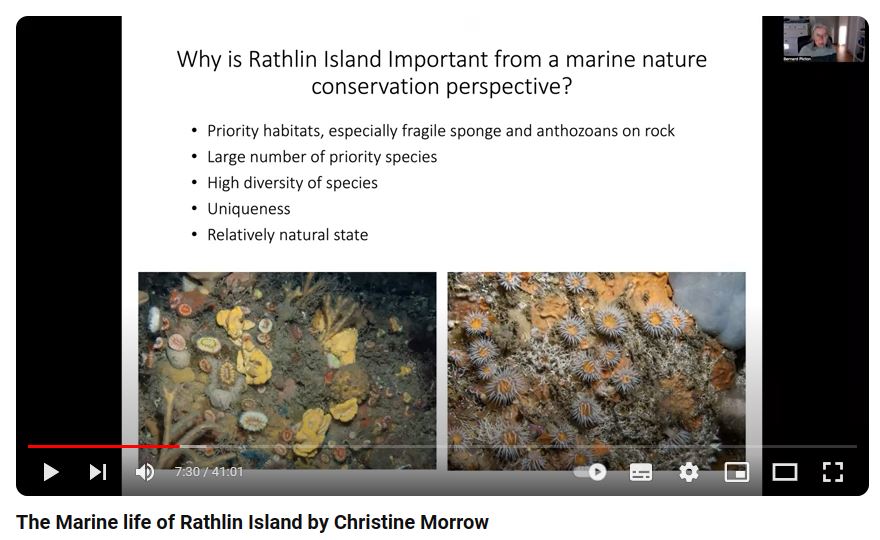
We’ve also gathered together a YouTube playlist of videos showing Rathlin’s marine life, including some wonderful dive footage that is nearly as good as being down there yourself. It also features Dive NI’s interesting interviews with Claire Goodwin talking about the 2005 Rathlin marine surveys that discovered 29 species of sponge new to science, Bernard Picton describing his work on marine invertebrates and the reef off Rathlin that is now known as Picton’s Reef in his honour, and Richard Laverty talking about his extensive experience diving around Rathlin.

Dolphins are another exciting feature of Rathlin’s marine life – check out our videos of various species of dolphin seen from Rathlin, Bottlenose Dolphins and Harbour Porpoises being the most frequently sighted.

3. Rathlin is brilliant for birdwatching – over 220 species of bird have been recorded here

In addition to the stupendous seabird colony, Rathlin is a great place to enjoy a fantastic array of other birdlife. The island hosts about 70 breeding species each year, including notable species such as Corncrake and Twite. It is also a stepping stone for many other species making their seasonal migrations. This makes spring and autumn particularly rewarding times for birding on Rathlin, as it is possible to observe a constant turnover of birds visiting the island, and among them there is always the tantalising potential for an exciting vagrant to drop in.
Since 2017, we’ve recorded observations of birds made by ourselves and others on Rathlin. Each year we’ve compiled these into an annual Rathlin Bird Report, in which you can find the details of breeding species, passage migrants and occasional vagrants, along with other interesting stuff and lots of nice piccies.
We also regularly post our latest sightings on X/Twitter, and we have several birdy YouTube playlists.
4. The best time to visit Rathlin is ANY TIME! There is much to enjoy and discover throughout the year

Bafflingly, many people seem to have the idea that May or June is the time to visit Rathlin. Sure, those are great times to visit, but if you only visit then you are definitely missing out on a lot of other awesome stuff!

You may even see one particular sign up somewhere on the island which boldly (and bizarrely) states “By far the best time to visit Rathlin is May”, and we have no idea what the writer of the sign that was thinking. By all means, do visit in May because May is fabulous, and of course what you are likely to see here changes as the seasons progress, but unless there’s some specific thing you’re wanting to see that only happens in May, then you will undoubtedly find the other months of the spring and summer are equally fabulous. We created a couple of wildlife calendars to show some of Rathlin’s seasonal highlights and what happens when, and you can find lots of details in our reports and blog posts if there is something you particularly want to see.

There’s also a great deal to enjoy during the autumn and winter months too, although less hardy souls may be put off by the weather and logistics potentially being more challenging (while others will relish the same!). What that sign should say is “Rathlin is stunning in every season, and there are wildlife wonders to witness in every month of the year.”
5. Rathlin has a golden form of the Irish Hare that is unique to the island

The Golden Hare is very special as it is possibly the only creature that is unique to Rathlin (although see the bit above about the intriguing form of colonial anemone Parazoanthus axinellae that has been observed here – another potential contender to share this status with the GH?).

We’ve written a blog post about the Golden Hare and how to tell it from the regular Irish Hares and Rabbits that you will more frequently encounter on Rathlin, and we’ve also uploaded a few video clips of various GH encounters.
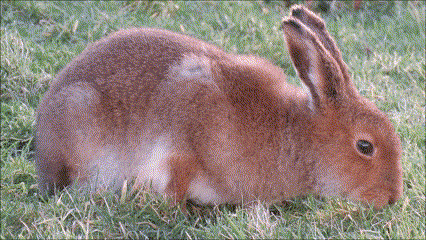
6. Rathlin is home to two species of seal

Rathlin is a fantastic place to see both Grey Seals and Common Seals, and to enjoy watching them resting at their haul out sites – just make sure to heed this important advice so that you avoid disturbing them.
We have written more about the differences between the two species in this blog post, which also describes our first efforts to observe and count the Grey Seal pups born on the island. During the 2023 pupping season we counted 190 Grey Seal pups born on Rathlin – we were quite amazed our total added up to this many, and no doubt there will have been even more that we weren’t able to see!
We’ve also made a Rathlin seal YouTube playlist of interesting seal behaviour including interactions between the two species.
7. Rathlin has wonderful wildflowers and a rich flora including numerous species that are rare in NI

We’ve written various blog posts on Rathlin’s flora, including the famous Pyramidal Bugle (Rathlin is the only site in NI for this species), other examples of the island’s great variety wildflowers (here and here), and even the Sphagnum mosses of Rathlin.
Having amassed hundreds of photos of Rathlin’s plants, we’ve used them to create an online gallery which now shows most of the wild vascular plants that have been recorded on the island – you can find that here.
We’ve also created a colourful poster showing the wildflowers of Rathlin.
8. Rathlin has a high diversity of grassland fungi including waxcaps
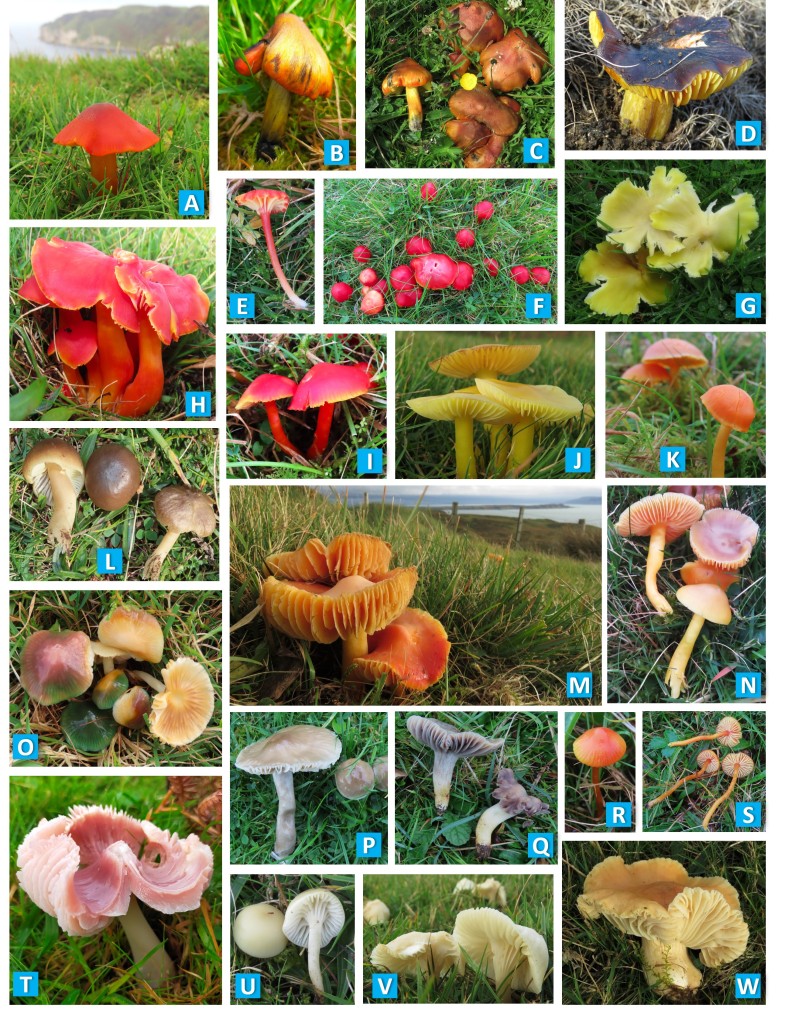
The high diversity of grassland fungi found on Rathlin is nationally and internationally important, and it’s down to the quality of the unimproved grassland habitats found on the island, something which is sadly becoming a rare thing elsewhere. Our post on the waxcaps of Rathlin covers the 31 species recorded on the island, including several species we have recently added ourselves.
9. Nearly 500 species of moths (including 19 butterflies) have been recorded on Rathlin

After our first four years of recording moths and butterflies on Rathlin, we wrote a report covering all the species that had been recorded on the island up to that point. This includes details on each species, lots of photos, and a handy page at the start summarising the most important things you should know about Rathlin’s Lepidoptera. Various notable species have been recorded on Rathlin, including species that are rare elsewhere, exciting migrants, and the only Irish records to date of Lempke’s Gold Spot.

10. New things are being discovered all the time and there is lots still to learn!

As an island, Rathlin still has high quality habitats due to being more protected than much of the mainland, and it is a stepping stone or haven for species that are on the move. This makes Rathlin a rich and dynamic place to observe wildlife, and we are continually making interesting new discoveries.
Every year we make numerous novel observations of Rathlin’s birds, including species that haven’t been seen on the island before, and sometimes never seen in Northern Ireland before (find all the details in our annual bird reports). We’ve also uncovered a few well-kept secrets of Rathlin’s birdlife, such as a small and very sneaky flock of White-fronted Geese wintering on the island each year, Treecreepers established as a breeding species, a pair of Razorbills caring for two chicks… and plenty more!

As covered above, we’ve greatly expanded Rathlin’s Lepidoptera list, and through our regular light trapping and searching in the field we’ve recorded many notable moth species, and one that was the first record for all of Ireland. We’ve even observed a couple of new butterfly species, including the arrival of the Holly Blue as (probably) a new colonist.
Other invertebrates are generally poorly recorded and so are fertile ground for new finds – there are so many we could mention here, but a few of our favourites include the first Vagrant Emperor for Northern Ireland, a thriving population of 24-spot Ladybirds, and Black Fern Aphids quietly living in Rathlin’s caves.
Among the flora, it’s a greater challenge to find vascular plants that botanists haven’t seen on Rathlin before, but we’ve found many species that haven’t been recorded for decades, and in some cases for centuries. Bryophytes offer much more bang for buck in terms of recording new species, and we discovered an even greater thrill among the carophytes – a very intriguing plant that is either something very rare, or something not yet described! Experts are currently puzzling over this one, and we will write more about it once we have their verdict.
We could go on (with fungi, for example), but we’ve probably made our case! Recording wildlife on Rathlin is something that we find incredibly enjoyable and rewarding, particularly as we are gradually expanding our collective knowledge about everything that is here. Who knows what we’ll discover next!

